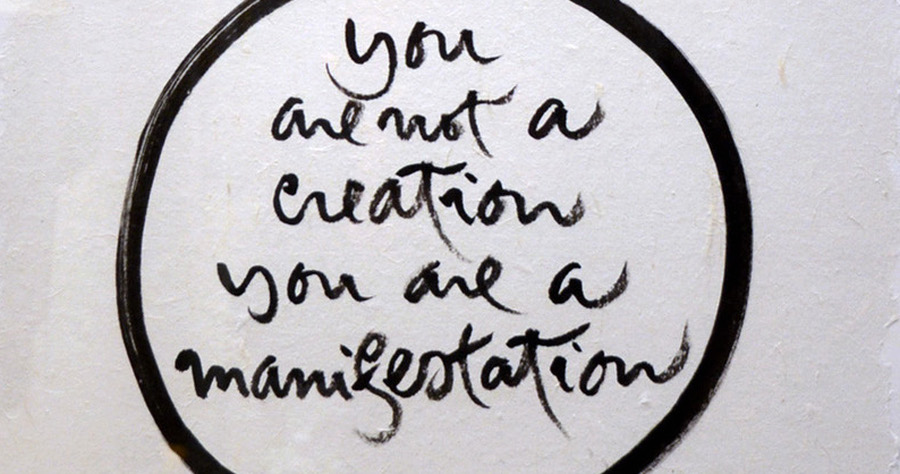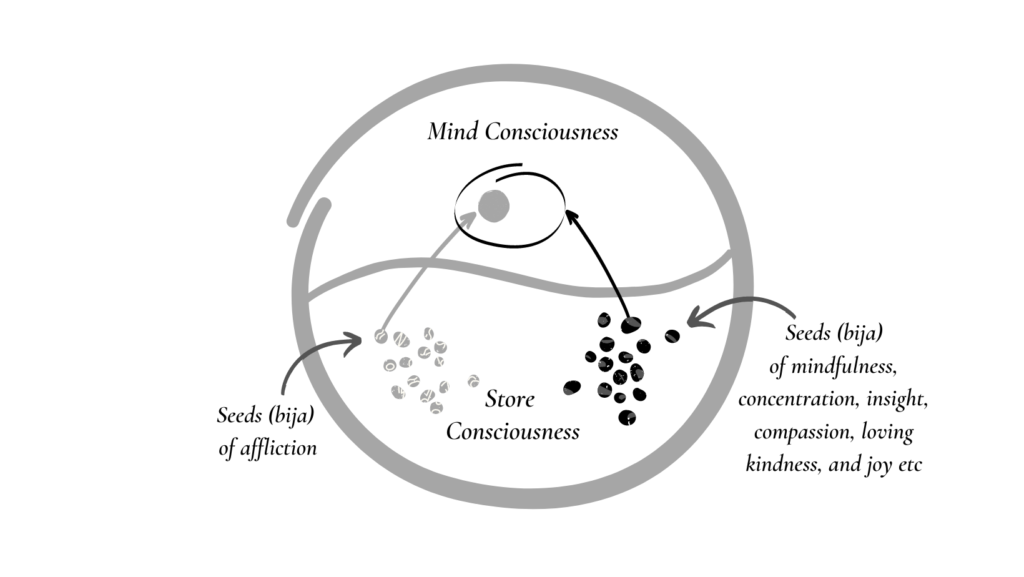Our mind is made of particles. Modern physics speaks about matter, reality as being made of subatomic particles. But in Buddhist psychology we speak about consciousness – mind – in terms of mental formations: very tiny particles that make up our mind.
‘Formation’ is translated from the word samskara. Anything that is formed, like a flower, is a formation. Many conditions have come together for a flower to manifest as a flower. The sunshine, rain, clouds, soil; many things come together and support a flower to manifest.
So, any compounded thing made up of different elements is called a physical formation. This cushion is also a formation; it is made of several elements. The bell is a formation, the marker is a formation. And my hand is a formation, a physiological formation. And my anger, my fear is a mental formation. So, the mind is made of mental formations like a river is made of drops of water.
In the Buddhist tradition, we speak of 51 categories of mental formations. There are good ones like compassion, love, non-violence, loving kindness, insight, mindfulness; many good mental formations. There are negative mental formations like fear, anger, despair, discrimination, and so on.
And then those mental formations which can be either positive or negative, like thinking. Thinking might be good in the case of right thinking. My thinking might be negative; my thinking might lead to suicide, but it might lead to understanding and compassion. So there are mental formations that can be either positive or negative.
When I was a student of the Buddhist Institute, I had to memorise all 51 categories, and when one manifested I had to be able to name it, to recognize it, and call it by its true name.

So the ninth exercise is that whenever there is a mental formation manifesting, you have to be able to recognize it and call it by its true name.
Suppose anger manifests. You say, ‘Hello, anger, I know you are a mental formation called anger. I will take good care of you.’
In Buddhist psychology, we speak of consciousness in terms of store and mind: store consciousness and mind consciousness.
Store consciousness is the kind of consciousness that has the power to receive, process, and store information. It is always there with the body. And in store consciousness there are seeds – a technical term in Buddhist psychology. The Sanskrit word is bija.
Seeds are particles that make up consciousness. They are down there in the form of particles, of seeds – like anger. When we are not angry, the seed of anger has not manifested, but it is always there. When we are having a good time, we are not angry at all. That does not mean that the seed of anger is not in us. If someone comes and touches it, says or does something to water the seed of anger in us, then that seed will manifest on the level of mind consciousness, as a mental formation: citta samskara.
And that energy of anger, that mental formation can stay there for a long time – or not; it depends on our practice. As good practitioners, we know that if we allow the mental formation of anger to stay too long, it will grow.
So, a good practitioner is not trying to suppress the energy of anger, because pushing it down doesn’t work. It comes up again, stronger. So trying to push it down sets up a barrier preventing it from coming up and that’s the way many of us do.
Fear, anger, loneliness: when they manifest up here, we feel that the landscape of mind consciousness is not beautiful, not pleasant. Therefore, we try to suppress, and the usual way is by consuming. There are those of us who just go and open the refrigerator and take something to eat. We are not hungry; we are eating in order to forget, to get busy in order to not to have to confront, to touch the mental formation that is anger or fear or loneliness.
Or we might watch the television – to cover up, to suppress. Many of us do that in our daily life. Or we take our car and go somewhere, or we take the phone and talk to someone – to ignore that mental formation. And the supermarket provides us with many means to help us suppress these mental formations that are ready to come up. Because, in our daily life, we are feeding them, and they become stronger and stronger. And if they are strong, they naturally want to push their way up. And if you suppress them during the day, they’ll come up during the night, in our dreams.
Many of us in society don’t know the practice; that is why we try to suppress these feelings by way of consumption, and we create a situation of bad circulation in the mind. And when the mental formation does not circulate well, symptoms of mental illness can appear. That is why it’s not good to set up a barrier up there. It’s good to allow mental formations to come up, if you are a good practitioner; invite the seed of mindfulness to come up.
We all have the seeds of mindfulness, concentration, insight, compassion, loving kindness, and joy. We have to make good use of them; we have to give them many chances to come up. That is what a good practitioner will do.

When you come to a retreat like this, we give them many chances. When we listen to a dharma talk, the dharma rain will water them and they will pop up very easily and give us joy and happiness and so on.
So, a good practitioner, while noticing the seed of anger or despair coming up, they would not try to suppress it but begin to breathe or to work mindfully, generating the energy of mindfulness to manifest. Because mindfulness is also a mental formation – a good one.
So, with the energy of mindfulness, we can recognize and embrace this tenderly. We do not fight; mindfulness isn’t going to fight or suppress anger. Mindfulness is about taking good care of anger, embracing it tenderly like a mother holding her baby. Any good practitioner should be able to do that. We have to learn to train ourselves to do that: ‘Hello, my little pain, I know you are there. I will take good care of you.’ And doing walking meditation, sitting meditation, mindful breathing, a kind of lullaby to the mental formation of pain.
After having been embraced by the energy of mindfulness, the mental formation will lose some of its strength. Like the ailing baby being embraced by a loving mother will suffer less and might stop crying.
So the mental formation, after having been embraced by the energy of mindfulness, will go down again to its original place, and lose a little bit of its energy. And that is why any time a negative mental formation manifests, we have to do something – and that something is not to suppress, to fight, but to invite the energy of mindfulness, concentration and insight to come up and to take care.
It’s like the mental formation is taking a bath of mindfulness, taking a bath of concentration before going down again. And if we know how to do this, we will restore the state of good circulation in our psyche, and the mental symptoms of illness will disappear after a few weeks, restoring the circulation of the mind.
So, exercise number nine is to become aware of any mental formation that manifests from down there to up here, including the negative ones.
[This transcript was edited for readability.]
Watch the teaching here:

Gracias
This is such a helpful way to think about negative emotions. All my life I’ve tried to suppress those emotions which I felt were wrong or shameful. To greet and acknowledge and care for them like a baby who needs to be held and attended to is very powerful and liberating. Thank you
This is such a beautiful reminder, to name it by it’s true name
Thank you all for you posting this again
Thank you. Before I would let mental formations overwhelm me. Still happens sometimes. But now I am learning to breathe and calm my habit energy by replacing the peg 😉 and inviting mindfulness.
Illuminating elucidation! But aren’t all feelings mental formations then? Whether be it resulting from physiological response (e.g., prickling / heat sensation on the skin) or emotional response (e.g., anger / dejection, envy / resentment), all that which can be ascribed or attributed to “feeling” (in the word’s general and broad sense) is a compounded product and output by and from the mind. Anyone shed some light, please?
I’m wondering the same. Why are feelings a seperate Establishment?